MNIST - Model induction
MNIST - handwritten digits/Model induction
We shall analyse this dataset using the NIST repository which depends on the AlignmentRepa repository.
Sections
Model 5 - 15-fud square regions of 10x10 pixels
Model 6 - Square regions of 10x10 pixels
Model 21 - Square regions of 15x15 pixels
Model 10 - Centred square regions of 11x11 pixels
Model 18 - Row and column regions
Model 24 - Two level over 10x10 regions
Model 25 - Two level over 15x15 regions
Model 26 - Two level over centred square regions of 11x11 pixels
Model 36 - Conditional level over 15-fud
Model 37 - Conditional level over all pixels
Model 38 - Conditional level over averaged pixels
NIST conditional over square regions
Model 43 - Conditional level over square regions of 15x15 pixels
Model 40 - Conditional level over two level over 10x10 regions
Model 41 - Conditional level over two level over 15x15 regions
Model 42 - Conditional level over two level centred square regions of 11x11 pixels
Model 1 - 15-fud
Consider a 15-fud induced model of 7500 events of the training sample. We shall run it in the interpreter,
:l NISTDev
(uu,hrtr) <- nistTrainBucketedIO 2
let digit = VarStr "digit"
let vv = uvars uu
let vvl = sgl digit
let vvk = vv `minus` vvl
let hr = hrev [i | i <- [0.. hrsize hrtr - 1], i `mod` 8 == 0] hrtr
let hrtr = undefined
let (wmax,lmax,xmax,omax,bmax,mmax,umax,pmax,fmax,mult,seed) = (2^10, 8, 2^10, 10, (10*3), 3, 2^8, 1, 15, 1, 5)
Just (uu1,df) <- decomperIO uu vvk hr wmax lmax xmax omax bmax mmax umax pmax fmax mult seed
This runs in the ghci interpreter on a Ubuntu 16.04 Pentium CPU G2030 @ 3.00GHz in 1333 seconds.
summation mult seed uu1 df hr
(148378.04791361679,74189.02395680839)
card $ dfund df
147
card $ fvars $ dfff df
535
BL.writeFile ("NIST_model1.json") $ decompFudsPersistentsEncode $ decompFudsPersistent df
Imaging the fud decomposition,
let file = "/tmp/NIST.bmp"
let hrbmav = hrbm 28 3 2 $ hr `hrhrred` vvk
let pp = qqll $ treesPaths $ hrmult uu1 df hr
rpln $ map (map (hrsize . snd)) pp
"[7500,2584,1203]"
"[7500,2584,1378,793]"
"[7500,4909,1681,687]"
"[7500,4909,1681,972]"
"[7500,4909,3221,1395,941]"
"[7500,4909,3221,1746,628]"
"[7500,4909,3221,1746,1118]"
bmwrite file $ bmvstack $ map (\bm -> bminsert (bmempty ((28*2)+2) (((28*2)+2)*(maximum (map length pp)))) 0 0 bm) $ map (bmhstack . map (\((_,ff),hrs) -> bmborder 1 (bmmax (hrbm 28 2 2 (hrs `hrhrred` vvk)) 0 0 (hrbm 28 2 2 (qqhr 2 uu vvk (fund ff)))))) pp
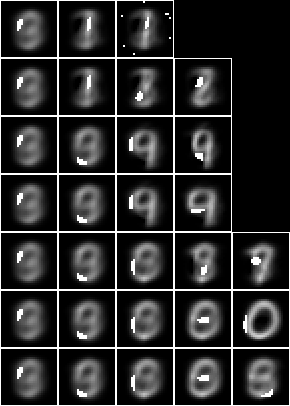
Both the averaged slice and the fud underlying are shown in each image to indicate where the attention is during decomposition.
Model 2 - 15-fud
Now consider a similar model but with a larger shuffle multiplier, mult,
:l NISTDev
(uu,hrtr) <- nistTrainBucketedIO 2
let digit = VarStr "digit"
let vv = uvars uu
let vvl = sgl digit
let vvk = vv `minus` vvl
let hr = hrev [i | i <- [0.. hrsize hrtr - 1], i `mod` 8 == 0] hrtr
let hrtr = undefined
let (wmax,lmax,xmax,omax,bmax,mmax,umax,pmax,fmax,mult,seed) = (2^10, 8, 2^10, 10, (10*3), 3, 2^8, 1, 15, 3, 5)
Just (uu1,df) <- decomperIO uu vvk hr wmax lmax xmax omax bmax mmax umax pmax fmax mult seed
This runs in the ghci interpreter on a Ubuntu 16.04 Pentium CPU G2030 @ 3.00GHz in 1785 seconds.
summation mult seed uu1 df hr
(122058.33490991575,59900.18390268337)
card $ dfund df
147
card $ fvars $ dfff df
542
BL.writeFile ("NIST_model2.json") $ decompFudsPersistentsEncode $ decompFudsPersistent df
Imaging the fud decomposition,
let pp = qqll $ treesPaths $ hrmult uu1 df hr
rpln $ map (map (hrsize . snd)) pp
"[7500,2584,584]"
"[7500,2584,1295,532]"
"[7500,2584,1295,749]"
"[7500,4513,1578,591]"
"[7500,4513,1578,964,595]"
"[7500,4513,2633,1154]"
"[7500,4513,2633,1235,764]"
bmwrite file $ bmvstack $ map (\bm -> bminsert (bmempty ((28*2)+2) (((28*2)+2)*(maximum (map length pp)))) 0 0 bm) $ map (bmhstack . map (\((_,ff),hrs) -> bmborder 1 (bmmax (hrbm 28 2 2 (hrs `hrhrred` vvk)) 0 0 (hrbm 28 2 2 (qqhr 2 uu vvk (fund ff)))))) pp
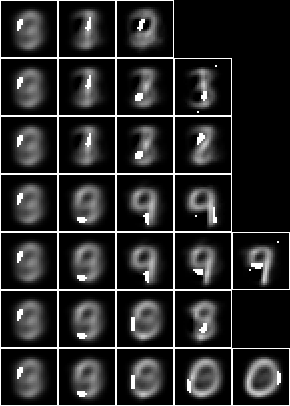
Both the averaged slice and the fud underlying are shown in each image to indicate where the attention is during decomposition.
Model 3 - All pixels
Now consider a compiled inducer. NIST_model3.json is induced by NIST_engine3.hs. The sample is the entire training set of 60,000 events.
NIST_engine3 may be built as described in README. Then run as follows -
stack exec NIST_engine3.exe +RTS -s >NIST_engine3.log 2>&1 &
tail -f NIST_engine3.log
The first section loads the sample,
(uu,hrtr) <- nistTrainBucketedIO 2
let digit = VarStr "digit"
let vv = uvars uu
let vvl = sgl digit
let vvk = vv `minus` vvl
Then the parameters are defined,
let model = "NIST_model3"
let (wmax,lmax,xmax,omax,bmax,mmax,umax,pmax,fmax,mult,seed) = (2^11, 8, 2^9, 40, (40*4), 4, 2^8, 1, 127, 1, 5)
In this case the parameters are such that NIST_engine3 runs on a Ubuntu 16.04 Intel(R) Xeon(R) Platinum 8175M CPU @ 2.50GHz using 1756 MB memory in 11505 seconds.
Then the decomper is run,
Just (uu1,df1) <- decomperIO uu vvk hr wmax lmax xmax omax bmax mmax umax pmax fmax mult seed
...
where
...
decomperIO uu vv hh wmax lmax xmax omax bmax mmax umax pmax fmax mult seed =
parametersSystemsHistoryRepasDecomperMaxRollByMExcludedSelfHighestFmaxIORepa
wmax lmax xmax omax bmax mmax umax pmax fmax mult seed uu vv hh
Then the model is written to NIST_model3.json,
BL.writeFile (model ++ ".json") $ decompFudsPersistentsEncode $ decompFudsPersistent df1
The summed alignment and the summed alignment valency-density are calculated,
let (a,ad) = summation mult seed uu1 df1 hr'
printf "alignment: %.2f\n" $ a
printf "alignment density: %.2f\n" $ ad
hFlush stdout
The statistics are,
model cardinality: 3715
selected train size: 7500
alignment: 165090.07
alignment density: 80621.53
Finally the images are written out,
let pp = qqll $ treesPaths $ hrmult uu1 df1 hr'
bmwrite (model ++ ".bmp") $ bmvstack $ map (\bm -> bminsert (bmempty (28+2) ((28+2)*(maximum (map length pp)))) 0 0 bm) $ map (bmhstack . map (\(_,hrs) -> bmborder 1 (hrbm 28 1 2 (hrs `hrhrred` vvk)))) $ pp
bmwrite (model ++ "_1.bmp") $ bmvstack $ map (\bm -> bminsert (bmempty ((28*1)+2) (((28*1)+2)*(maximum (map length pp)))) 0 0 bm) $ map (bmhstack . map (\((_,ff),hrs) -> bmborder 1 (bmmax (hrbm 28 1 2 (hrs `hrhrred` vvk)) 0 0 (hrbm 28 1 2 (qqhr 2 uu vvk (fund ff)))))) $ pp
bmwrite (model ++ "_2.bmp") $ bmvstack $ map (\bm -> bminsert (bmempty ((28*2)+2) (((28*2)+2)*(maximum (map length pp)))) 0 0 bm) $ map (bmhstack . map (\((_,ff),hrs) -> bmborder 1 (bmmax (hrbm 28 2 2 (hrs `hrhrred` vvk)) 0 0 (hrbm 28 2 2 (qqhr 2 uu vvk (fund ff)))))) $ pp

Now with the fud underlying superimposed on the averaged slice,

Model 4 - All pixels
Similarly, the NIST_model4.json is induced by NIST_engine4.hs. The sample is the entire training set of 60,000 events. The parameters are defined,
let model = "NIST_model4"
let (wmax,lmax,xmax,omax,bmax,mmax,umax,pmax,fmax,mult,seed) = (2^11, 8, 2^10, 60, (60*3), 3, 2^8, 1, 127, 1, 5)
This engine runs on a Ubuntu 16.04 Intel(R) Xeon(R) Platinum 8175M CPU @ 2.50GHz using 1673 MB memory in 18875 seconds.
The statistics are,
model cardinality: 4062
selected train size: 7500
alignment: 143760.91
alignment density: 71292.00
Imaging the fud decomposition,

Now with the fud underlying superimposed on the averaged slice,

Model 35 - All pixels
Similarly, the NIST_model35.json is induced by NIST_engine35.hs. The sample is the entire training set of 60,000 events. The parameters are defined,
let model = "NIST_model35"
let (wmax,lmax,xmax,omax,bmax,mmax,umax,pmax,fmax,mult,seed) = (2^11, 8, 2^10, 30, (30*3), 3, 2^8, 1, 127, 1, 5)
This engine runs on a Ubuntu 16.04 Intel(R) Xeon(R) Platinum 8175M CPU @ 2.50GHz using 1410 MB memory in 10759 seconds.
The statistics are,
model cardinality: 3929
selected train size: 7500
alignment: 129988.66
alignment density: 63698.56
Imaging the fud decomposition,

Now with the fud underlying superimposed on the averaged slice,

Model 34 - Averaged pixels
The pixel variables can be averaged as well as bucketed to reduce the dimension from 28x28 to 9x9. The NIST_model34.json is induced by NIST_engine34.hs. The sample is the entire training set of 60,000 events. The first section loads the sample,
(uu,hr) <- nistTrainBucketedAveragedIO 8 9 0
The parameters are defined,
let model = "NIST_model34"
let (wmax,lmax,xmax,omax,bmax,mmax,umax,pmax,fmax,mult,seed) = (2^11, 8, 2^10, 30, (30*3), 3, 2^8, 1, 127, 1, 5)
The engine runs on a Intel(R) Xeon(R) Platinum 8175M CPU @ 2.50GHz using 572 MB memory in 8239 seconds.
The statistics are,
model cardinality: 4811
selected train size: 7500
alignment: 89445.55
alignment density: 43702.20
Imaging the fud decomposition,

Now with the fud underlying superimposed on the averaged slice,

Model 5 - 15-fud square regions of 10x10 pixels
Now consider a 15-fud induced model applied to 7500 events of randomly chosen square regions of 10x10 pixels from the training sample. We shall run it in the interpreter,
:l NISTDev
(uu,hrtr) <- nistTrainBucketedRegionRandomIO 2 10 17
let digit = VarStr "digit"
let vv = uvars uu
let vvl = sgl digit
let vvk = vv `minus` vvl
let hr = hrev [i | i <- [0 .. hrsize hrtr - 1], i `mod` 8 == 0] hrtr
let (wmax,lmax,xmax,omax,bmax,mmax,umax,pmax,fmax,mult,seed) = (2^10, 8, 2^10, 10, (10*3), 3, 2^8, 1, 15, 2, 5)
Just (uu1,df) <- decomperIO uu vvk hr wmax lmax xmax omax bmax mmax umax pmax fmax mult seed
This runs in the ghci interpreter on a Ubuntu 16.04 Pentium CPU G2030 @ 3.00GHz in 773 seconds.
summation mult seed uu1 df hr
(125116.57866462508,62558.28933231254)
card $ dfund df
98
card $ fvars $ dfff df
483
BL.writeFile ("NIST_model5.json") $ decompFudsPersistentsEncode $ decompFudsPersistent df
Imaging the fud decomposition,
let pp = qqll $ treesPaths $ hrmult uu1 df hr
rpln $ map (map (hrsize . snd)) pp
"[7500,3442,1606,915,677,605]"
"[7500,3442,1606,640]"
"[7500,3442,1639,1075]"
"[7500,3679,1233]"
"[7500,3679,2440,741]"
"[7500,3679,2440,1673,1011]"
bmwrite file $ bmvstack $ map (\bm -> bminsert (bmempty ((10*3)+2) (((10*3)+2)*(maximum (map length pp)))) 0 0 bm) $ map (bmhstack . map (\((_,ff),hrs) -> bmborder 1 (bmmax (hrbm 10 3 2 (hrs `hrhrred` vvk)) 0 0 (hrbm 10 3 2 (qqhr 2 uu vvk (fund ff)))))) pp
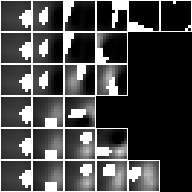
Both the averaged slice and the fud underlying are shown in each image to indicate where the attention is during decomposition.
Now showing just the averaged slice,
bmwrite file $ bmvstack $ map (\bm -> bminsert (bmempty ((10*3)+2) (((10*3)+2)*(maximum (map length pp)))) 0 0 bm) $ map (bmhstack . map (\((_,ff),hrs) -> bmborder 1 (hrbm 10 3 2 (hrs `hrhrred` vvk)))) pp
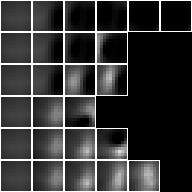
Model 6 - Square regions of 10x10 pixels
Now consider a compiled inducer. NIST_model6.json is induced by NIST_engine6.hs. The sample is the entire training set of 60,000 events.
The first section loads the sample,
(uu,hr) <- nistTrainBucketedRegionRandomIO 2 10 17
The parameters are defined,
let model = "NIST_model6"
let (wmax,lmax,xmax,omax,bmax,mmax,umax,pmax,fmax,mult,seed) = (2^11, 8, 2^10, 30, (30*3), 3, 2^8, 1, 127, 1, 5)
The engine runs on a Intel(R) Xeon(R) Platinum 8175M CPU @ 2.50GHz using 655 MB memory in 9774 seconds.
The statistics are,
model cardinality: 3659
selected train size: 7500
alignment: 184576.58
alignment density: 91637.01
Imaging the fud decomposition,

Now with the fud underlying superimposed on the averaged slice,

Model 21 - Square regions of 15x15 pixels
Now consider a compiled inducer. NIST_model21.json is induced by NIST_engine21.hs. The sample is the entire training set of 60,000 events.
The first section loads the sample,
(uu,hr) <- nistTrainBucketedRegionRandomIO 2 15 17
The parameters are defined,
let model = "NIST_model21"
let (wmax,lmax,xmax,omax,bmax,mmax,umax,pmax,fmax,mult,seed) = (2^11, 8, 2^10, 30, (30*3), 3, 2^8, 1, 127, 1, 5)
The engine runs on a Intel(R) Xeon(R) Platinum 8175M CPU @ 2.50GHz using 714 MB memory in 10245 seconds.
The statistics are,
model cardinality: 4086
selected train size: 7500
alignment: 175450.03
alignment density: 87200.26
Imaging the fud decomposition,

Now with the fud underlying superimposed on the averaged slice,

Model 10 - Centred square regions of 11x11 pixels
NIST_model10.json is induced by NIST_engine10.hs. The sample is the entire training set of 60,000 events.
The first section loads the sample,
(uu,hrtr) <- nistTrainBucketedRegionRandomIO 2 11 17
let u = stringsVariable "<6,6>"
let hr = hrtr `hrhrsel` aahr uu (unit (sgl (llss [(u,ValInt 1)])))
let digit = VarStr "digit"
let vv = uvars uu
let vvl = sgl digit
let vvk = vv `minus` vvl
Then the parameters are defined,
let model = "NIST_model10"
let (wmax,lmax,xmax,omax,bmax,mmax,umax,pmax,fmax,mult,seed) = (2^11, 8, 2^10, 30, (30*3), 3, 2^8, 1, 127, 1, 5)
The engine runs on a Intel(R) Xeon(R) Platinum 8175M CPU @ 2.50GHz using 552 MB memory in 8320 seconds.
The statistics are,
model cardinality: 3975
selected train size: 7500
alignment: 29422.85
alignment density: 14570.72
Imaging the fud decomposition,

Now with the fud underlying superimposed on the averaged slice,

Model 18 - Row and column regions
NIST_model18_rows.json and NIST_model18_cols.json are induced by NIST_engine18.hs. The sample is the entire training set of 60,000 events.
The first section loads the sample. For columns,
(uu,hr) <- nistTrainBucketedRectangleRandomIO 2 28 1 17
or for rows,
(uu,hr) <- nistTrainBucketedRectangleRandomIO 2 1 28 17
let digit = VarStr "digit"
let vv = uvars uu
let vvl = sgl digit
let vvk = vv `minus` vvl
Then the parameters are defined,
let model = "NIST_model18_cols"
or for rows,
let model = "NIST_model18_rows"
let (wmax,lmax,xmax,omax,bmax,mmax,umax,pmax,fmax,mult,seed) = (2^11, 8, 2^10, 30, (30*3), 3, 2^8, 1, 127, 1, 5)
The engine runs on a Intel(R) Xeon(R) Platinum 8175M CPU @ 2.50GHz using 737 MB memory in 13967 seconds.
Then the decomper is run,
Just (uu1,df1) <- decomperIO uu vvk hr wmax lmax xmax omax bmax mmax umax pmax fmax mult seed
Then the models are written to NIST_model18_rows.json and NIST_model18_cols.json.
Model 24 - Two level over 10x10 regions
Now consider 5x5 copies of the Model 6 - Square regions of 10x10 pixels over the whole query substrate. NIST_model24.json is induced by NIST_engine24.hs. The sample is the entire training set of 60,000 events.
The first section loads the underlying sample,
(uu,hr) <- nistTrainBucketedRegionRandomIO 2 10 17
Then the underlying decomposition is loaded, reduced, converted to a nullable fud, and reframed at level 1,
s <- BL.readFile "./NIST_model6.json"
let df1 = fromJust $ persistentsDecompFud $ fromJust $ (Data.Aeson.decode s :: Maybe DecompFudPersistent)
let uu1 = uu `uunion` (fsys (dfff df1))
let ff1 = fframe (refr1 1) $ dfnul uu1 (dfred uu1 df1 hr) 1
where
dfred = systemsDecompFudsHistoryRepasDecompFudReduced
dfnul uu df g = fromJust $ systemsDecompFudsNullablePracticable uu df g
refr1 k (VarPair (VarPair (VarInt f, l), VarInt i)) = VarPair (VarPair (VarPair (VarPair (VarInt k, VarInt f), VarInt 0), l), VarInt i)
refr1 k (VarPair (VarPair (VarPair (VarInt f, g), l), VarInt i)) = VarPair (VarPair (VarPair (VarPair (VarInt k, VarInt f), g), l), VarInt i)
refr1 _ v = v
Then the sample is loaded,
(uu,hr) <- nistTrainBucketedIO 2
let digit = VarStr "digit"
let vv = uvars uu
let vvl = sgl digit
let vvk = vv `minus` vvl
Then the underlying model is copied and reframed at level 2,
let gg1 = foldl funion fudEmpty [fframe (refr2 x y) ff1 | x <- [2,6,10,14,18], y <- [2,6,10,14,18]]
let uu1 = uu `uunion` (fsys gg1)
where
refr2 x y (VarPair (VarInt i, VarInt j)) = VarPair (VarInt ((x-1)+i), VarInt ((y-1)+j))
refr2 x y v = VarPair (v, VarStr ("(" ++ show x ++ ";" ++ show y ++ ")"))
Then the parameters are defined,
let model = "NIST_model24"
let (wmax,lmax,xmax,omax,bmax,mmax,umax,pmax,fmax,mult,seed) = (2^11, 8, 2^10, 30, (30*3), 3, 2^8, 1, 127, 1, 5)
Then the decomper is run,
Just (uu2,df2) <- decomperIO uu1 gg1 hr wmax lmax xmax omax bmax mmax umax pmax fmax mult seed
...
where
...
decomperIO uu ff aa wmax lmax xmax omax bmax mmax umax pmax fmax mult seed =
parametersSystemsHistoryRepasDecomperLevelMaxRollByMExcludedSelfHighestFmaxIORepa wmax lmax xmax omax bmax mmax umax pmax fmax mult seed uu (Tree $ Map.singleton (wmax,Set.empty,ff) emptyTree) aa
The engine runs on a Intel(R) Xeon(R) Platinum 8175M CPU @ 2.50GHz using 28791 MB memory in 28540 seconds.
The statistics are,
model cardinality: 6158
selected train size: 7500
alignment: 197806.78
alignment density: 94133.43
Imaging the fud decomposition,

Now with the fud underlying superimposed on the averaged slice,

Model 25 - Two level over 15x15 regions
Now consider 5x5 copies of the Model 21 - Square regions of 15x15 pixels over the whole query substrate. NIST_model25.json is induced by NIST_engine25.hs. The sample is the entire training set of 60,000 events.
The engine is very similar to Model 24 - Two level over 10x10 regions. The first section loads the underlying sample,
(uu,hr) <- nistTrainBucketedRegionRandomIO 2 15 17
Then the underlying decomposition is loaded, reduced, converted to a nullable fud, and reframed at level 1,
s <- BL.readFile "./NIST_model21.json"
let df1 = fromJust $ persistentsDecompFud $ fromJust $ (Data.Aeson.decode s :: Maybe DecompFudPersistent)
let uu1 = uu `uunion` (fsys (dfff df1))
let ff1 = fframe (refr1 1) $ dfnul uu1 (dfred uu1 df1 hr) 1
where
dfred = systemsDecompFudsHistoryRepasDecompFudReduced
dfnul uu df g = fromJust $ systemsDecompFudsNullablePracticable uu df g
refr1 k (VarPair (VarPair (VarInt f, l), VarInt i)) = VarPair (VarPair (VarPair (VarPair (VarInt k, VarInt f), VarInt 0), l), VarInt i)
refr1 k (VarPair (VarPair (VarPair (VarInt f, g), l), VarInt i)) = VarPair (VarPair (VarPair (VarPair (VarInt k, VarInt f), g), l), VarInt i)
refr1 _ v = v
Then the sample is loaded,
(uu,hr) <- nistTrainBucketedIO 2
let digit = VarStr "digit"
let vv = uvars uu
let vvl = sgl digit
let vvk = vv `minus` vvl
Then the underlying model is copied and reframed at level 2,
let gg1 = foldl funion fudEmpty [fframe (refr2 x y) ff1 | x <- [1,4,7,10,13], y <- [1,4,7,10,13]]
let uu1 = uu `uunion` (fsys gg1)
where
refr2 x y (VarPair (VarInt i, VarInt j)) = VarPair (VarInt ((x-1)+i), VarInt ((y-1)+j))
refr2 x y v = VarPair (v, VarStr ("(" ++ show x ++ ";" ++ show y ++ ")"))
Then the parameters are defined,
let model = "NIST_model25"
let (wmax,lmax,xmax,omax,bmax,mmax,umax,pmax,fmax,mult,seed) = (2^11, 8, 2^10, 30, (30*3), 3, 2^8, 1, 127, 1, 5)
Then the decomper is run,
Just (uu2,df2) <- decomperIO uu1 gg1 hr wmax lmax xmax omax bmax mmax umax pmax fmax mult seed
...
where
...
decomperIO uu ff aa wmax lmax xmax omax bmax mmax umax pmax fmax mult seed =
parametersSystemsHistoryRepasDecomperLevelMaxRollByMExcludedSelfHighestFmaxIORepa wmax lmax xmax omax bmax mmax umax pmax fmax mult seed uu (Tree $ Map.singleton (wmax,Set.empty,ff) emptyTree) aa
The engine runs on a Intel(R) Xeon(R) Platinum 8175M CPU @ 2.50GHz using 29036 MB memory in 30648 seconds.
The statistics are,
model cardinality: 5194
selected train size: 7500
alignment: 197744.69
alignment density: 96419.64
Imaging the fud decomposition,

Now with the fud underlying superimposed on the averaged slice,

Model 26 - Two level over centred square regions of 11x11 pixels
Now consider 5x5 copies of the Model 10 - Centred square regions of 11x11 pixels over the whole query substrate. NIST_model26.json is induced by NIST_engine26.hs. The sample is the entire training set of 60,000 events.
The engine is very similar to Model 24 - Two level over 10x10 regions and Model 25 - Two level over 15x15 regions. The first section loads the underlying sample,
(uu,hr) <- nistTrainBucketedRegionRandomIO 2 11 17
Then the underlying decomposition is loaded, reduced, converted to a nullable fud, and reframed at level 1,
s <- BL.readFile "./NIST_model10.json"
let df1 = fromJust $ persistentsDecompFud $ fromJust $ (Data.Aeson.decode s :: Maybe DecompFudPersistent)
let uu1 = uu `uunion` (fsys (dfff df1))
let ff1 = fframe (refr1 1) $ dfnul uu1 (dfred uu1 df1 hr) 1
where
dfred = systemsDecompFudsHistoryRepasDecompFudReduced
dfnul uu df g = fromJust $ systemsDecompFudsNullablePracticable uu df g
refr1 k (VarPair (VarPair (VarInt f, l), VarInt i)) = VarPair (VarPair (VarPair (VarPair (VarInt k, VarInt f), VarInt 0), l), VarInt i)
refr1 k (VarPair (VarPair (VarPair (VarInt f, g), l), VarInt i)) = VarPair (VarPair (VarPair (VarPair (VarInt k, VarInt f), g), l), VarInt i)
refr1 _ v = v
Then the sample is loaded,
(uu,hr) <- nistTrainBucketedIO 2
let digit = VarStr "digit"
let vv = uvars uu
let vvl = sgl digit
let vvk = vv `minus` vvl
Then the underlying model is copied and reframed at level 2,
let gg1 = foldl funion fudEmpty [fframe (refr2 x y) ff1 | x <- [2,6,10,14,18], y <- [2,6,10,14,18]]
let uu1 = uu `uunion` (fsys gg1)
where
refr2 x y (VarPair (VarInt i, VarInt j)) = VarPair (VarInt ((x-1)+i), VarInt ((y-1)+j))
refr2 x y v = VarPair (v, VarStr ("(" ++ show x ++ ";" ++ show y ++ ")"))
Then the parameters are defined,
let model = "NIST_model26"
let (wmax,lmax,xmax,omax,bmax,mmax,umax,pmax,fmax,mult,seed) = (2^11, 8, 2^10, 30, (30*3), 3, 2^8, 1, 127, 1, 5)
Then the decomper is run,
Just (uu2,df2) <- decomperIO uu1 gg1 hr wmax lmax xmax omax bmax mmax umax pmax fmax mult seed
...
where
...
decomperIO uu ff aa wmax lmax xmax omax bmax mmax umax pmax fmax mult seed =
parametersSystemsHistoryRepasDecomperLevelMaxRollByMExcludedSelfHighestFmaxIORepa wmax lmax xmax omax bmax mmax umax pmax fmax mult seed uu (Tree $ Map.singleton (wmax,Set.empty,ff) emptyTree) aa
The engine runs on a Intel(R) Xeon(R) Platinum 8175M CPU @ 2.50GHz using 24516 MB memory in 28273 seconds.
The statistics are,
model cardinality: 7701
selected train size: 7500
alignment: 158648.92
alignment density: 78295.49
Imaging the fud decomposition,
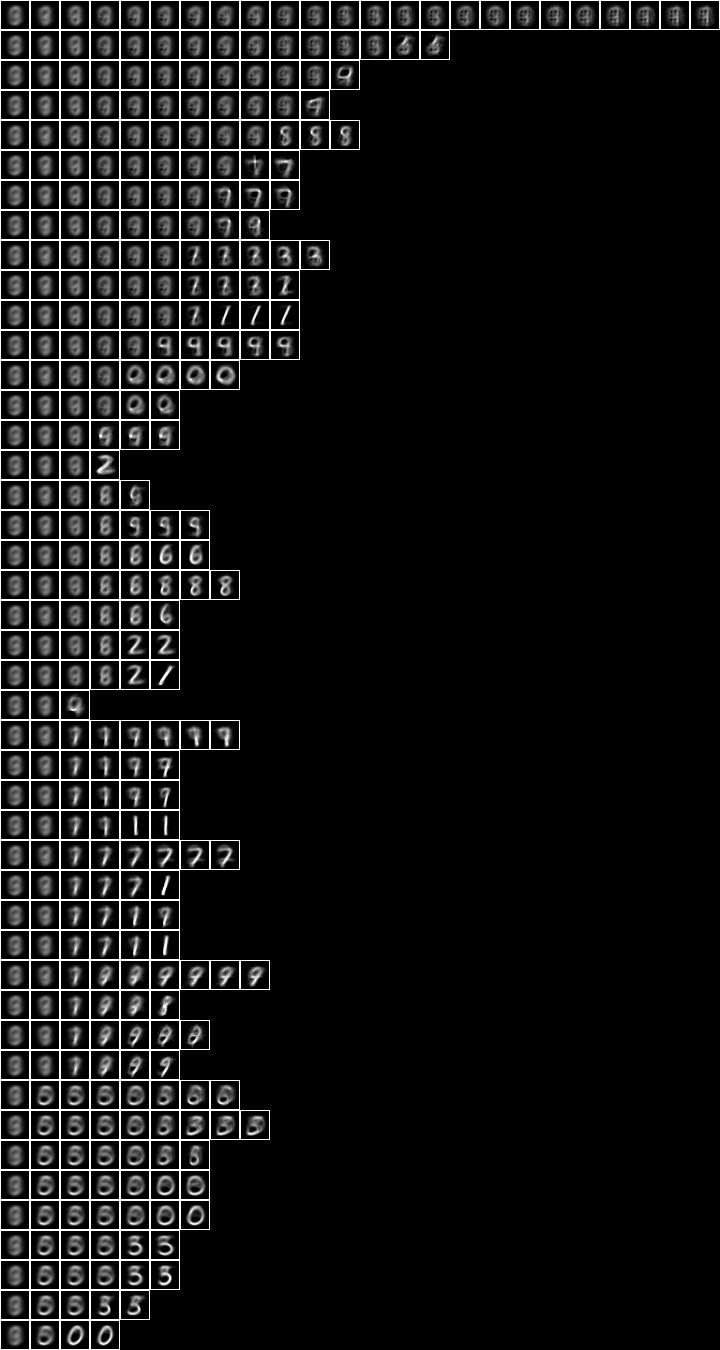
Now with the fud underlying superimposed on the averaged slice,
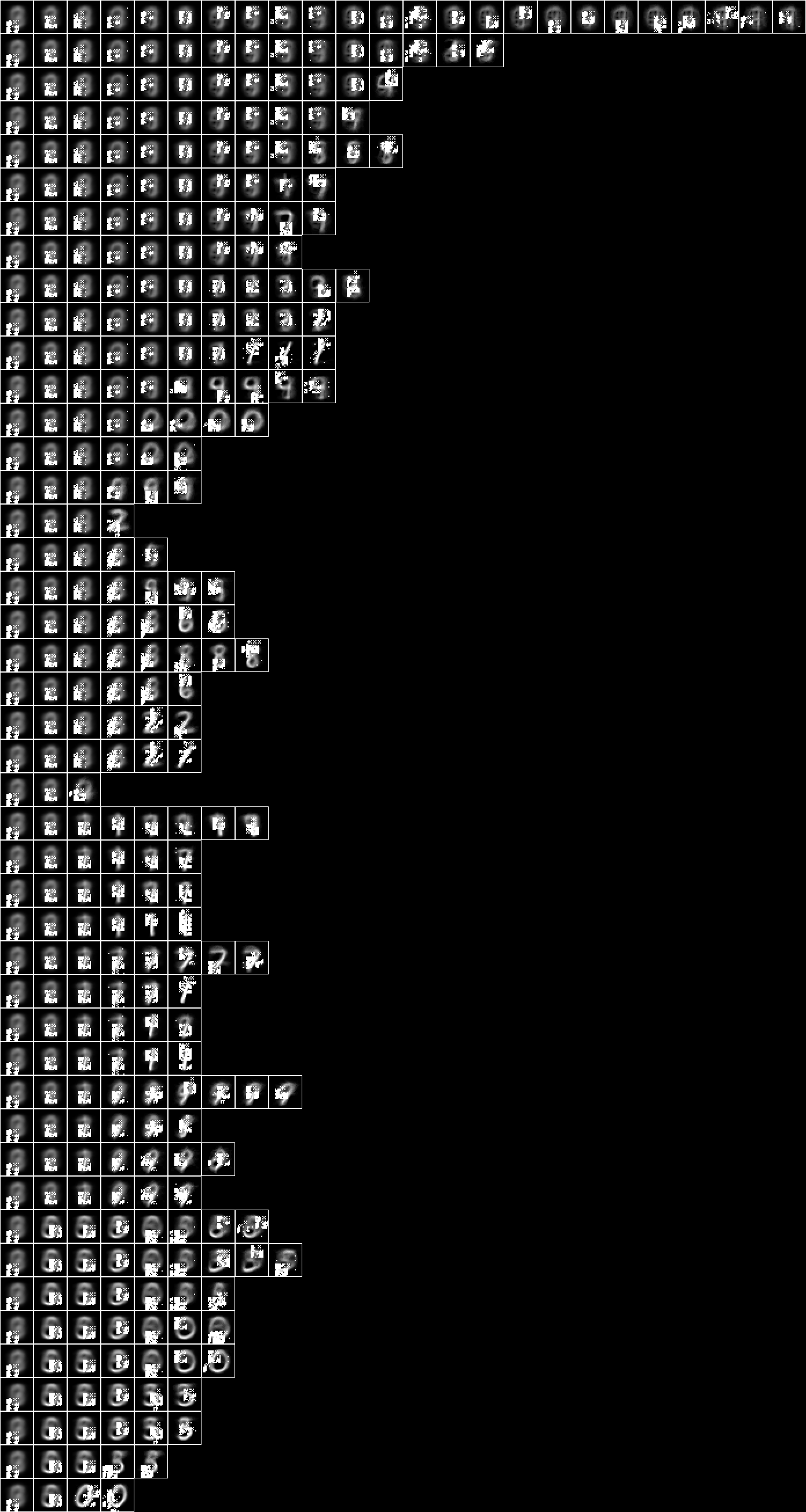
NIST test
Some of the models above are very large, so the label tests are best run compiled. The NIST_test.hs is executed as follows,
stack exec NIST_test.exe NIST_model2 +RTS -s
model: NIST_model2
selected train size: 7500
model cardinality: 542
nullable fud cardinality: 711
nullable fud derived cardinality: 143
nullable fud underlying cardinality: 147
ff label ent: 1.3524518741683345
test size: 1000
effective size: 986 % 1
matches: 463
This runs on model 2 on a Ubuntu 16.04 Pentium CPU G2030 @ 3.00GHz in 470 MB memory in 86 seconds.
The first section loads the sample and the model,
[model] <- getArgs
(uu,hrtr) <- nistTrainBucketedIO 2
let hr = hrev [i | i <- [0.. hrsize hrtr - 1], i `mod` 8 == 0] hrtr
let digit = VarStr "digit"
let vv = uvars uu
let vvl = sgl digit
let vvk = vv `minus` vvl
s <- BL.readFile (model ++ ".json")
let df1 = fromJust $ persistentsDecompFud $ fromJust $ (Data.Aeson.decode s :: Maybe DecompFudPersistent)
Then the fud decomposition fud is created,
let uu1 = uu `uunion` (fsys (dfff df1))
let ff1 = fromJust $ systemsDecompFudsNullablePracticable uu1 df1 9
Then the label entropy is calculated,
let uu1 = uu `uunion` (fsys ff1)
let hr1 = hrfmul uu1 ff1 hr
printf "ff label ent: %.16f\n" $ hrlent uu1 hr1 (fder ff1) vvl
Lastly, the test history is loaded and the query effectiveness and query accuracy is calculated,
(uu,hrte) <- nistTestBucketedIO 2
let hrq = hrev [i | i <- [0 .. hrsize hrte - 1], i `mod` 10 == 0] hrte
let hrq1 = hrfmul uu1 ff1 hrq
printf "effective size: %s\n" $ rp $ size $ hhaa (hrhh uu1 (hrq1 `hrhrred` (fder ff1))) `mul` eff (hhaa (hrhh uu1 (hr1 `hrhrred` (fder ff1))))
printf "matches: %d\n" $ length [rr | let hhq = hrhh uu1 (hrq1 `hrhrred` (fder ff1 `union` vvl)), let aa = hhaa (hrhh uu1 (hr1 `hrhrred` (fder ff1 `union` vvl))), (_,ss) <- hhll hhq, let qq = single ss 1, let rr = aa `mul` (qq `red` fder ff1) `red` vvl, size rr > 0, size (amax rr `mul` (qq `red` vvl)) > 0]
NIST conditional
Given an induced model, this engine finds a semi-supervised submodel that predicts the label variables, $V_{\mathrm{l}}$, or digit, by optimising conditional entropy. Consider NIST_engine_cond.hs. The first section loads the parameters, sample and the model,
[valency_s,modelin,kmax_s,omax_s,fmax_s,model] <- getArgs
let (valency,kmax,omax,fmax) = (read valency_s, read kmax_s, read omax_s, read fmax_s)
(uu,hr) <- nistTrainBucketedIO valency
let digit = VarStr "digit"
let vv = uvars uu
let vvl = sgl digit
let vvk = vv `minus` vvl
df1 <- dfIO (modelin ++ ".json")
Then the fud decomposition fud is created,
let uu1 = uu `uunion` (fsys (dfff df1))
let ff1 = fframe (refr1 3) $ dfnul uu1 df1 3
Then the model is applied,
let uu1 = uu `uunion` (fsys ff1)
let hr1 = hrfmul uu1 ff1 hr
Then the conditional entropy fud decomper is run,
let (uu2,df2) = decompercondrr vvl uu1 hr1 kmax omax fmax
let df2' = zzdf $ funcsTreesMap (\(ss,ff) -> (ss, (ff `funion` ff1) `fdep` fder ff)) $ dfzz df2
where
decompercondrr vvl uu aa kmax omax fmax = fromJust $ parametersSystemsHistoryRepasDecomperConditionalFmaxRepa kmax omax fmax uu vvl aa
Then the model is written to NIST_model36.json,
BL.writeFile (model ++ ".json") $ decompFudsPersistentsEncode $ decompFudsPersistent df2'
Finally the images are written out,
let pp = qqll $ treesPaths $ hrmult uu2 df2' hr'
bmwrite (model ++ ".bmp") $ bmvstack $ map (\bm -> bminsert (bmempty (28+2) ((28+2)*(maximum (map length pp)))) 0 0 bm) $ map (bmhstack . map (\(_,hrs) -> bmborder 1 (hrbm 28 1 2 (hrs `hrhrred` vvk)))) $ pp
bmwrite (model ++ "_1.bmp") $ bmvstack $ map (\bm -> bminsert (bmempty ((28*1)+2) (((28*1)+2)*(maximum (map length pp)))) 0 0 bm) $ map (bmhstack . map (\((_,ff),hrs) -> bmborder 1 (bmmax (hrbm 28 1 2 (hrs `hrhrred` vvk)) 0 0 (hrbm 28 1 2 (qqhr 2 uu vvk (fund ff)))))) $ pp
bmwrite (model ++ "_2.bmp") $ bmvstack $ map (\bm -> bminsert (bmempty ((28*2)+2) (((28*2)+2)*(maximum (map length pp)))) 0 0 bm) $ map (bmhstack . map (\((_,ff),hrs) -> bmborder 1 (bmmax (hrbm 28 2 2 (hrs `hrhrred` vvk)) 0 0 (hrbm 28 2 2 (qqhr 2 uu vvk (fund ff)))))) $ pp
Model 36 - Conditional level over 15-fud
Now run the conditional entropy fud decomper to create Model 36, the conditional level over 15-fud induced model of all pixels, Model 2,
stack exec NIST_engine_cond.exe 2 NIST_model2 1 5 15 NIST_model36 +RTS -s >NIST_engine36.log 2>&1
This runs on on a Ubuntu 16.04 Pentium CPU G2030 @ 3.00GHz in 1754 MB memory in 180 seconds.
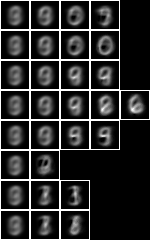
Now with the fud underlying superimposed on the averaged slice,
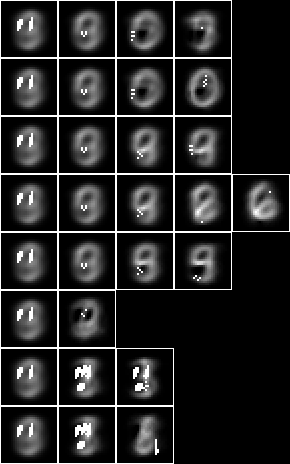
If we run NIST test on the new model,
stack exec NIST_test.exe NIST_model36 +RTS -s >NIST_test_model36.log 2>&1
we obtain the following statistics,
model: NIST_model36
selected train size: 7500
model cardinality: 206
nullable fud cardinality: 246
nullable fud derived cardinality: 15
nullable fud underlying cardinality: 87
ff label ent: 1.3402902066958342
test size: 1000
effective size: 1000 % 1
matches: 534
Model 37 - Conditional level over all pixels
Now let us repeat the analysis of Model 36, but for the conditional level over 127-fud induced model of all pixels, Model 35. Model 37 -
stack exec NIST_engine_cond.exe 2 NIST_model35 1 5 127 NIST_model37 +RTS -s >NIST_engine37.log 2>&1
This runs on on a Ubuntu 16.04 AMD EPYC 7571 cpu @ 2199.522 MHz in 9380 MB memory in 4705 seconds.

Now with the fud underlying superimposed on the averaged slice,

If we run NIST test on the new model,
stack exec NIST_test.exe NIST_model37 +RTS -s >NIST_test_model37.log 2>&1
we obtain the following statistics,
model: NIST_model37
selected train size: 7500
model cardinality: 650
nullable fud cardinality: 1026
nullable fud derived cardinality: 127
nullable fud underlying cardinality: 255
ff label ent: 0.5951985228651324
test size: 1000
effective size: 999 % 1
matches: 814
Repeating the same, but with 2-tuple conditional,
stack exec NIST_engine_cond.exe 2 NIST_model35 2 5 127 NIST_model39 +RTS -s >NIST_engine39.log 2>&1
This runs on on a Ubuntu 16.04 AMD EPYC 7571 cpu @ 2199.522 MHz in 7167 MB memory in 24283 seconds.

Now with the fud underlying superimposed on the averaged slice,

If we run NIST test on the new model,
stack exec NIST_test.exe NIST_model39 +RTS -s >NIST_test_model39.log 2>&1
we obtain the following statistics,
model: NIST_model39
selected train size: 7500
model cardinality: 883
nullable fud cardinality: 1253
nullable fud derived cardinality: 127
nullable fud underlying cardinality: 322
ff label ent: 0.3877749488432780
test size: 1000
effective size: 985 % 1
matches: 824
Model 38 - Conditional level over averaged pixels
Now let us repeat the analysis for the conditional level over 127-fud induced model of averaged pixels, Model 34.
Consider NIST_engine_cond_averaged.hs. The first section loads the parameters, sample and the model,
[valency_s,breadth_s,offset_s,modelin,kmax_s,omax_s,fmax_s,model] <- getArgs
let (valency,breadth,offset,kmax,omax,fmax) = (read valency_s, read breadth_s, read offset_s, read kmax_s, read omax_s, read fmax_s)
(uu,hr) <- nistTrainBucketedAveragedIO valency breadth offset
let digit = VarStr "digit"
let vv = uvars uu
let vvl = sgl digit
let vvk = vv `minus` vvl
df1 <- dfIO (modelin ++ ".json")
The remainder is as for Model 36.
Now run Model 38 -
stack exec NIST_engine_cond_averaged.exe 8 9 0 NIST_model34 1 5 127 NIST_model38 +RTS -s >NIST_engine38.log 2>&1
This runs on on a Ubuntu 16.04 AMD EPYC 7571 cpu @ 2199.522 MHz in 9068 MB memory in 5094 seconds.

Now with the fud underlying superimposed on the averaged slice,

NIST test averaged
We must modify NIST test to allow for an averaged substrate. NIST_test_averaged.hs is executed as follows,
stack exec NIST_test_averaged.exe 8 9 0 NIST_model38 +RTS -s >NIST_test_model38.log 2>&1
we obtain the following statistics,
model: NIST_model38
selected train size: 7500
model cardinality: 419
nullable fud cardinality: 794
nullable fud derived cardinality: 127
nullable fud underlying cardinality: 46
ff label ent: 0.6267873188842659
test size: 1000
effective size: 990 % 1
matches: 701
NIST conditional over square regions
We can modify NIST conditional to copy an array of region models. Consider NIST_engine_cond_regions.hs. The first section loads the parameters, regional sample and the regional model,
[valency_s,breadth_s,seed_s,ufmax_s,locations_s,modelin,kmax_s,omax_s,fmax_s,model] <- getArgs
let [valency,breadth,seed] = map read [valency_s,breadth_s,seed_s] :: [Int]
let [ufmax,kmax,omax,fmax] = map read [ufmax_s,kmax_s,omax_s,fmax_s] :: [Integer]
let locations = map read $ words locations_s
(uu,hr) <- nistTrainBucketedRegionRandomIO valency breadth seed
df1 <- dfIO (modelin ++ ".json")
Then the fud decomposition fud is created,
let uu1 = uu `uunion` (fsys (dfff df1))
let ff1 = fframe (refr1 3) $ dfnul uu1 (df1 `dflt` ufmax) 3
Then the sample is loaded,
(uu,hr) <- nistTrainBucketedIO valency
let digit = VarStr "digit"
let vv = uvars uu
let vvl = sgl digit
let vvk = vv `minus` vvl
Then the model is copied,
let gg1 = foldl funion fudEmpty [fframe (refr2 x y) ff1 | x <- locations, y <- locations]
Then the model is applied,
let uu1 = uu `uunion` (fsys gg1)
let hr1 = hrfmul uu1 gg1 hr
Then the conditional entropy fud decomper is run,
let (uu2,df2) = decompercondrr vvl uu1 hr1 kmax omax fmax
let df2' = zzdf $ funcsTreesMap (\(ss,ff) -> (ss, (ff `funion` gg1) `fdep` fder ff)) $ dfzz df2
where
decompercondrr vvl uu aa kmax omax fmax = fromJust $ parametersSystemsHistoryRepasDecomperConditionalFmaxRepa kmax omax fmax uu vvl aa
The remainder of the engine is as for NIST conditional.
Model 43 - Conditional level over square regions of 15x15 pixels
Now run the regional conditional entropy fud decomper to create Model 43, the conditional level over a 7x7 array of 127-fud induced models of square regions of 15x15 pixels, Model 21,
stack exec NIST_engine_cond_regions.exe 2 15 17 31 "1 3 5 7 9 11 13" NIST_model21 1 5 127 NIST_model43 +RTS -s >NIST_engine43.log 2>&1
This runs on on a Ubuntu 16.04 AMD EPYC 7571 cpu @ 2199.522 MHz in 35928 MB memory in 24283 seconds.

Now with the fud underlying superimposed on the averaged slice,

If we run NIST test on the new model,
stack exec NIST_test.exe NIST_model43 +RTS -s >NIST_test_model43.log 2>&1
we obtain the following statistics,
model: NIST_model43
selected train size: 7500
model cardinality: 2034
nullable fud cardinality: 2410
nullable fud derived cardinality: 127
nullable fud underlying cardinality: 361
ff label ent: 0.5642948913994976
test size: 1000
effective size: 997 % 1
matches: 808
Model 40 - Conditional level over two level over 10x10 regions
Now run the conditional entropy fud decomper over the 2-level induced model Model 24 to create Model 40,
stack exec NIST_engine_cond.exe 2 NIST_model24 1 5 127 NIST_model40 +RTS -s >NIST_engine40.log 2>&1
This runs on on a Ubuntu 16.04 AMD EPYC 7571 cpu @ 2199.522 MHz in 12640 MB memory in 13741 seconds.

Now with the fud underlying superimposed on the averaged slice,

If we run NIST test on the new model,
stack exec NIST_test.exe NIST_model40 +RTS -s >NIST_test_model40.log 2>&1
we obtain the following statistics,
model: NIST_model40
selected train size: 7500
model cardinality: 2296
nullable fud cardinality: 2671
nullable fud derived cardinality: 127
nullable fud underlying cardinality: 589
ff label ent: 0.5850540595121823
test size: 1000
effective size: 1000 % 1
matches: 794
Model 41 - Conditional level over two level over 15x15 regions
Now run the conditional entropy fud decomper over the 2-level induced model Model 25 to create Model 41,
stack exec NIST_engine_cond.exe 2 NIST_model25 1 5 127 NIST_model41 +RTS -s >NIST_engine41.log 2>&1
This runs on on a Ubuntu 16.04 AMD EPYC 7571 cpu @ 2199.522 MHz in 11261 MB memory in 10998 seconds.

Now with the fud underlying superimposed on the averaged slice,

If we run NIST test on the new model,
stack exec NIST_test.exe NIST_model41 +RTS -s >NIST_test_model41.log 2>&1
we obtain the following statistics,
model: NIST_model41
selected train size: 7500
model cardinality: 1522
nullable fud cardinality: 1897
nullable fud derived cardinality: 127
nullable fud underlying cardinality: 452
ff label ent: 0.5974764620331507
test size: 1000
effective size: 994 % 1
matches: 791
Model 42 - Conditional level over centred square regions of 11x11 pixels
Now run the conditional entropy fud decomper over the 2-level induced model Model 26 to create Model 42,
stack exec NIST_engine_cond.exe 2 NIST_model26 1 5 127 NIST_model42 +RTS -s >NIST_engine42.log 2>&1
This runs on on a Ubuntu 16.04 AMD EPYC 7571 cpu @ 2199.522 MHz in 15636 MB memory in 17241 seconds.

Now with the fud underlying superimposed on the averaged slice,

If we run NIST test on the new model,
stack exec NIST_test.exe NIST_model42 +RTS -s >NIST_test_model42.log 2>&1
we obtain the following statistics,
model: NIST_model42
selected train size: 7500
model cardinality: 835
nullable fud cardinality: 1211
nullable fud derived cardinality: 127
nullable fud underlying cardinality: 311
ff label ent: 0.6526213410903168
test size: 1000
effective size: 1000 % 1
matches: 786